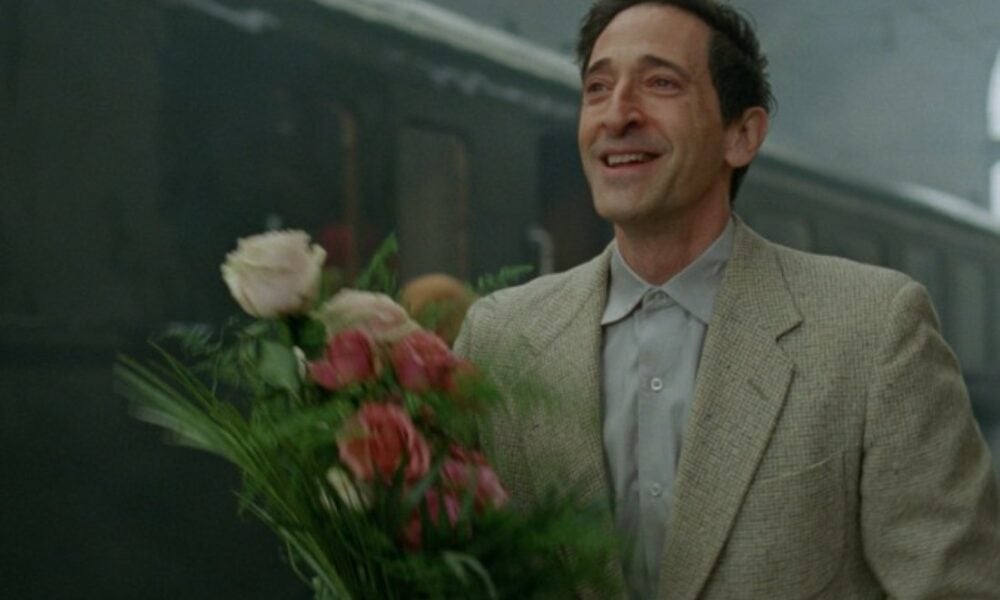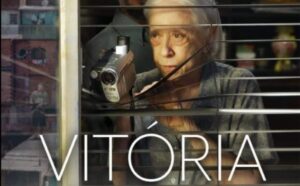Bathroom break! “The Brutalist” will have a 15-minute intermission during screenings in Brazil. The film, a favorite for the 2025 Oscars, received 10 nominations
“The Brutalist,” directed by João Costa, introduces an unprecedented novelty in Brazilian cinema: all screenings of the film will have a 15-minute intermission. With its dense and complex plot, this measure aims to provide more comfort to the audience and allow for a break to reflect on the events unfolding on screen. The film, which stands out for its innovative visual approach and provocative screenplay, is considered one of the main contenders for the 2025 Oscars, receiving no less than 10 nominations, including Best Picture, Best Director, and Best Original Screenplay. Its Brazilian release is scheduled for February 13, 2025.
The idea of including intermissions in films is not new in other countries, but in Brazil, where uninterrupted screenings are firmly established, the decision to introduce a break has stirred some controversy. For many, this could alter the immersive experience of cinema. On the other hand, the idea seems to be a response to the increasing number of long-duration productions, such as “The Brutalist,” which, at 2 hours and 15 minutes, demands a significant commitment from the audience. The intermission, therefore, is seen as a way to make the experience more comfortable and enjoyable, particularly for those seeking a more relaxed session without losing the narrative’s momentum.
With its release set for February, the film is already generating high expectations. Specialized critics have highlighted the strength of “The Brutalist” as an innovative production both in its technical aspects and its narrative. The brutalist architectural style that permeates the entire production not only reflects in the setting but also symbolizes the protagonist’s struggle, an architect obsessed with creating his masterpiece. The film serves as a critique of modern society, addressing themes such as identity, power, and the relationship between humans and their creations.
The Revolution of Intermissions in Brazilian Cinema
With the rise of films that last more than two hours, like “The Brutalist,” many viewers are beginning to question whether long movie screenings are becoming exhausting. In several countries, the concept of intermissions is already common, allowing the audience to stand up, stretch, discuss what they’ve seen so far, or simply take a break. The introduction of a 15-minute intermission for “The Brutalist” in Brazil could be the starting point for a shift in the way films are screened in the country, especially in a context where long-duration films are becoming more frequent.
Intermissions are a growing trend in international markets, particularly in countries where film durations are increasingly extended. However, Brazilian cinema has a strong tradition of uninterrupted screenings. João Costa’s film breaks this pattern, but in a careful way, aiming to keep the audience’s attention intact. The 15-minute intermission will be strategically placed at key points in the plot to ensure that the narrative remains fluid. The pause will also serve as an opportunity for the audience to reflect on what they’ve seen so far and, in a way, even anticipate the upcoming events.
Although the intermission was conceived as a practical solution to make the experience more accessible and comfortable, it also serves as a challenge to the audience. By splitting the session, this decision could cause emotional detachment during the screening, which is always a risk for a film that seeks to maintain continuous tension. How the audience will react to this innovation can only be assessed when the film is widely released, but undoubtedly, this change will be a significant factor in the future of long-duration film screenings in Brazil.
Why “The Brutalist” Is a Favorite for the 2025 Oscars
“The Brutalist” is not just a film about architecture or a man’s struggle with his masterpiece. It is a cinematic work that transcends genres and presents a deep reflection on human nature. The film has been praised at various international festivals, and its 10 Oscar nominations are a reflection of its impact. The story revolves around an architect, played by the talented Rafael Silva, who finds himself torn between his obsession with creating his masterpiece and the consequences of his choices.
The protagonist’s relationship with brutalism, an architectural style known for its impersonal and grandiose forms, is central to the plot. In the film, architecture serves as a metaphor for the internal tensions of the characters and their respective journeys. The critique of modern society, focused on themes such as the pursuit of perfection and the impact of monumental works on personal lives, is one of the elements that has garnered the film praise from critics and film scholars alike.
With cinematography by one of the most respected names in the film industry today, the movie features stunning visuals that use brutalist architecture to build visual tension that complements the psychological narrative. The film’s aesthetic, with its long takes and scenes that explore light and shadow, is one of the main reasons it is considered a favorite for Best Cinematography. The script, which blends elements of drama and social critique, is also regarded as one of the most innovative and daring in recent years, particularly for its handling of the theme of obsession and the search for meaning.
Brutalist Architecture and Its Influence in Cinema
Brutalist architecture, which emerged in the 1950s, is often seen as a radical form of art, associated with concrete, geometric shapes, and an “ugly” aesthetic. However, “The Brutalist” does not treat architecture solely as a visual style, but as a metaphor for the complexity of human relationships. The protagonist’s obsession with his creation is a reflection of the role art and creation play in people’s lives. When faced with the consequences of his choices, the protagonist begins to question the true value of his search for perfection.
Brutalist architecture, with its impersonal and cold buildings, was chosen to represent the emotional disconnect the protagonist feels with those around him. The use of such settings also serves as a critique of modern society, which often prioritizes aesthetic perfection and functionality over human relationships and emotional needs. Architecture, therefore, is not only the backdrop of the film but an essential element in understanding the drama and emotions of the characters.
The Cultural and Social Impact of “The Brutalist”
The film also raises important questions about the impact of architecture on society and human relationships. By portraying an architect obsessed with his creation, “The Brutalist” questions how far individuals are willing to sacrifice their personal relationships in the name of professional success or the pursuit of perfection. The choice of such a deep and relevant theme is one of the reasons the film is considered a strong contender for the 2025 Oscars.
Statistics and Figures about “The Brutalist”
- Film Duration: 2 hours and 15 minutes
- Intermission: 15 minutes in all screenings in Brazil
- Oscar Nominations for 2025: 10 (Best Picture, Best Director, Best Original Screenplay, Best Cinematography)
- Brazil Release Date: February 13, 2025
- Main Cast: Rafael Silva, Maria Clara Souza, João Pereira
- Architectural Style: Brutalism
- Main Locations: São Paulo, Brasília, and Rio de Janeiro

“The Brutalist,” directed by João Costa, introduces an unprecedented novelty in Brazilian cinema: all screenings of the film will have a 15-minute intermission. With its dense and complex plot, this measure aims to provide more comfort to the audience and allow for a break to reflect on the events unfolding on screen. The film, which stands out for its innovative visual approach and provocative screenplay, is considered one of the main contenders for the 2025 Oscars, receiving no less than 10 nominations, including Best Picture, Best Director, and Best Original Screenplay. Its Brazilian release is scheduled for February 13, 2025.
The idea of including intermissions in films is not new in other countries, but in Brazil, where uninterrupted screenings are firmly established, the decision to introduce a break has stirred some controversy. For many, this could alter the immersive experience of cinema. On the other hand, the idea seems to be a response to the increasing number of long-duration productions, such as “The Brutalist,” which, at 2 hours and 15 minutes, demands a significant commitment from the audience. The intermission, therefore, is seen as a way to make the experience more comfortable and enjoyable, particularly for those seeking a more relaxed session without losing the narrative’s momentum.
With its release set for February, the film is already generating high expectations. Specialized critics have highlighted the strength of “The Brutalist” as an innovative production both in its technical aspects and its narrative. The brutalist architectural style that permeates the entire production not only reflects in the setting but also symbolizes the protagonist’s struggle, an architect obsessed with creating his masterpiece. The film serves as a critique of modern society, addressing themes such as identity, power, and the relationship between humans and their creations.
The Revolution of Intermissions in Brazilian Cinema
With the rise of films that last more than two hours, like “The Brutalist,” many viewers are beginning to question whether long movie screenings are becoming exhausting. In several countries, the concept of intermissions is already common, allowing the audience to stand up, stretch, discuss what they’ve seen so far, or simply take a break. The introduction of a 15-minute intermission for “The Brutalist” in Brazil could be the starting point for a shift in the way films are screened in the country, especially in a context where long-duration films are becoming more frequent.
Intermissions are a growing trend in international markets, particularly in countries where film durations are increasingly extended. However, Brazilian cinema has a strong tradition of uninterrupted screenings. João Costa’s film breaks this pattern, but in a careful way, aiming to keep the audience’s attention intact. The 15-minute intermission will be strategically placed at key points in the plot to ensure that the narrative remains fluid. The pause will also serve as an opportunity for the audience to reflect on what they’ve seen so far and, in a way, even anticipate the upcoming events.
Although the intermission was conceived as a practical solution to make the experience more accessible and comfortable, it also serves as a challenge to the audience. By splitting the session, this decision could cause emotional detachment during the screening, which is always a risk for a film that seeks to maintain continuous tension. How the audience will react to this innovation can only be assessed when the film is widely released, but undoubtedly, this change will be a significant factor in the future of long-duration film screenings in Brazil.
Why “The Brutalist” Is a Favorite for the 2025 Oscars
“The Brutalist” is not just a film about architecture or a man’s struggle with his masterpiece. It is a cinematic work that transcends genres and presents a deep reflection on human nature. The film has been praised at various international festivals, and its 10 Oscar nominations are a reflection of its impact. The story revolves around an architect, played by the talented Rafael Silva, who finds himself torn between his obsession with creating his masterpiece and the consequences of his choices.
The protagonist’s relationship with brutalism, an architectural style known for its impersonal and grandiose forms, is central to the plot. In the film, architecture serves as a metaphor for the internal tensions of the characters and their respective journeys. The critique of modern society, focused on themes such as the pursuit of perfection and the impact of monumental works on personal lives, is one of the elements that has garnered the film praise from critics and film scholars alike.
With cinematography by one of the most respected names in the film industry today, the movie features stunning visuals that use brutalist architecture to build visual tension that complements the psychological narrative. The film’s aesthetic, with its long takes and scenes that explore light and shadow, is one of the main reasons it is considered a favorite for Best Cinematography. The script, which blends elements of drama and social critique, is also regarded as one of the most innovative and daring in recent years, particularly for its handling of the theme of obsession and the search for meaning.
Brutalist Architecture and Its Influence in Cinema
Brutalist architecture, which emerged in the 1950s, is often seen as a radical form of art, associated with concrete, geometric shapes, and an “ugly” aesthetic. However, “The Brutalist” does not treat architecture solely as a visual style, but as a metaphor for the complexity of human relationships. The protagonist’s obsession with his creation is a reflection of the role art and creation play in people’s lives. When faced with the consequences of his choices, the protagonist begins to question the true value of his search for perfection.
Brutalist architecture, with its impersonal and cold buildings, was chosen to represent the emotional disconnect the protagonist feels with those around him. The use of such settings also serves as a critique of modern society, which often prioritizes aesthetic perfection and functionality over human relationships and emotional needs. Architecture, therefore, is not only the backdrop of the film but an essential element in understanding the drama and emotions of the characters.
The Cultural and Social Impact of “The Brutalist”
The film also raises important questions about the impact of architecture on society and human relationships. By portraying an architect obsessed with his creation, “The Brutalist” questions how far individuals are willing to sacrifice their personal relationships in the name of professional success or the pursuit of perfection. The choice of such a deep and relevant theme is one of the reasons the film is considered a strong contender for the 2025 Oscars.
Statistics and Figures about “The Brutalist”
- Film Duration: 2 hours and 15 minutes
- Intermission: 15 minutes in all screenings in Brazil
- Oscar Nominations for 2025: 10 (Best Picture, Best Director, Best Original Screenplay, Best Cinematography)
- Brazil Release Date: February 13, 2025
- Main Cast: Rafael Silva, Maria Clara Souza, João Pereira
- Architectural Style: Brutalism
- Main Locations: São Paulo, Brasília, and Rio de Janeiro











Post Comment